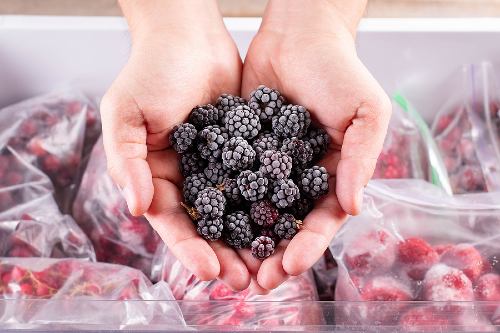Fruits and vegetables are an important part of the diet for everyone. The nutrients in these food groups help keep our bodies healthy, strong and thriving.
A diet high in fruits and vegetables is usually lower in fat, salt, and calories and provides essential vitamins, minerals for overall health. At least half of each meal you eat should be fruits and veggies. [1] However, it is important to remember that fruits and vegetables do not need to be fresh to still give you health benefits. Fresh, frozen, canned, or dried—all forms count toward your daily intake!
As a part of our Food Talk Features… Series, we have a handful of blogs that can help you determine how many fruits and vegetables you need in your diet. Check out the blogs below for information on these food groups and some tasty recipes to make with them!
- Berries and Summer Fruits
- Beans and Lentils and Starchy Vegetables
- Dark Green Vegetables
- Red and Orange Vegetables
Avoiding Waste and Spoilage
If you are worried about spoilage, think about buying shelf-stable varieties of fruit or veggies. Canned, frozen, and dried items last longer than fresh produce while keeping their nutritional value.
- Fruits and vegetables hold up well in the freezer. You can quickly add frozen veggies to soups, spaghetti sauce, or other hot dishes.
- Frozen or canned fruit can be added to low-fat yogurt or a smoothie for a refreshing sweet treat.
Note: when purchasing these pantry staples, make sure to look for “low-sodium,” “no salt added,” and “no added sugar” options. Salt and added sugars are both nutrients that you should limit in the foods you eat each day. [2]

Setting an Example
Fruits and vegetables are important for the health of your whole family. If you are a parent or grandparent, aunt or uncle, it is especially important for you to eat fruit and vegetables. Kids follow role models, and their role model is you! They are likely to be inspired by you if you eat fruits and vegetables.
Want to learn more about setting an example for your kids? Check out www.fruitsandveggies.org for special messages about why fruits and vegetables are where it’s at. You and your child can even take the Have A Plant® Pledge to add one more serving of fruits or vegetables to your meals every day for a month! Imagine what a difference that could make.

Including Fruits and Veggies in Your Diet
Let’s put it all together. Here are five ways to add more fruits and vegetables that are family- and budget-friendly!
- Shop locally.
- There are many benefits to shopping locally, including supporting your local economy and accessing produce at the peak of freshness.
- Did you know that many farmers markets double SNAP benefits? In Georgia, this program is called “Fresh for Less,” and it allows SNAP participants to match their benefits- dollar for dollar- at participating markets. [3] To find a list of farmers markets in your area where you can stretch your buying power, click here.
- Buy bags of frozen veggies when they’re on sale.
- Store them in the freezer and add them to cooked soups or with melted cheese on top.
- Freeze your own fresh fruit.
- When it’s on sale, buy more than you need. Rinse the fruit under water, pat dry, and slice it up. Then put it in an airtight bag and stick it in the freezer.
- Frozen bananas, pears, and blueberries make great snacks for kids. Serve peanut butter or our simple Cinnamon Dip for a tasty dip for these treats.
- Make smoothies a ‘thing’ in your house.
- Kids love colorful foods, so you can add fresh spinach and make a green smoothie, strawberries for a red smoothie, blueberries for a blue smoothie – or a combination for a mystery smoothie!
- Add low-fat milk or low-fat yogurt and buy frozen veggies to save on money and avoid spoilage.
- Use family favorite recipes as a way to sneak in more veggies.
- Encourage kids to eat their greens, make sweet potatoes more often, and add okra when it’s in season.
- Consider grilling, baking, or steaming these vegetables, as frying can add extra fat and calories.

You have the power to add more fruits and vegetables to your family’s diet. Try one new idea each month and see how it goes. Check out the following recipes ideas for ways to use fresh, frozen, and canned fruits and vegetables in your weekly menu!
Written by Sarah Stotz, Ph.D., RDN, LD, and Darci Bell, RDN, LD | Reviewed by Leslie Davis, MS, RD, LD, CDCES, and the Nutrition Education Team
Posted: September 6, 2021
